Announced at the same time as the Nikon Z 6, the Z 7 is a high-resolution full-frame mirrorless camera with the new 55mm-diameter Nikon Z-mount.
Like the Z 6’s, the Z 7’s sensor has a BSI (backside-illuminated) design, but its effective pixel count is 45.7MP rather than 24.5MP. This chip is coupled with Nikon’s Expeed 6 processing engine, which enables a native sensitivity range of ISO 64-25,600 and continuous shooting at up to 9fps (frames per second).
Unlike Nikon’s DSLRs, the Z-series cameras have a hybrid autofocus (AF) system that combines contrast- and phase-detection focusing. The Z 7 has a total of 493 AF points that cover approximately 90% of the imaging area.
Nikon has made the Z 7’s body from magnesium alloy and has sealed the joints and controls to make it dust and weather-resistant. There’s also a 0.5-inch 3.69-million-dot electronic viewfinder and a 3.2-inch 2,100,000-dot tilting touchscreen for composing and viewing images.
In addition to stills, the Z 7 can record video at up to 4K UHD (3840 x 2160) resolution. Footage may be recorded internally at 8bit, or at 10bit 4:2:2 if an external recorder is connected via the HDMI port.
Like the Z 6, the Z 7 has a single XQD card port that a firmware update will make compatible with CFexpress cards.
Key specifications:
- 45.7MP full-frame BSI CMOS sensor
- Hybrid AF with 493 points
- In-body 5-axis image stabilization
- Expeed 6 processor
- ISO 64-25,600, expandable to ISO 32-102,400
- Up to 9fps shooting
- UHD 4K at 30fps and 1080p at 120fps video
- Single XQD card slot
Overall performance
The Nikon Z 7’s 45.7MP full-frame BSI CMOS sensor achieves an impressive score of 99, which is the fifth-highest score we have seen to date. Its key strength is its (Portrait) color depth, which at 26.3 bits puts it in the bronze medal position among all the sensors we’ve tested—including small- and medium-format devices.
At 14.6EV, the Z 7’s (Landscape) dynamic range score is also exceptionally high and just 0.2EV behind the top-ranked model (the Hasselblad X1D-50c).
With such a high pixel count, it’s not really a surprise to find that the Z 7’s low-light ISO (Sports) score (ISO 2668) is its weakest area. But it has the highest-ranked 45MP full-frame sensor for this measurement, and all the sensors ahead of it are either larger (medium format) or have lower resolution.
Combining a high pixel count with excellent color depth and extensive dynamic range makes the Z 7 an attractive proposition for landscape, still life, and portrait photography.
Image quality compared
Because of its pixel count, build quality, and range of features, Nikon has referred to the Z 7 as a “mirrorless D850.” And our testing bears this out: for the sensor, the Z 7 comes very close to the D850, just falling 0.1 bit behind with its (Portrait) color depth score and 0.2EV behind with its (Landscape) dynamic range score. And at 2668 vs. 2660, the Z 7’s low-light ISO (Sports) score is effectively the same as the D850’s.
As the table below shows, the 45.7MP Nikon Z 7’s scores are very close to those of the 42.4MP Sony A7R III. While the Z 7 leads for color depth and dynamic range, the A7R III copes better with low light.
Low-light ISO is the one measurement for which the 24MP Nikon Z 6 outperforms the Z 7, and this is because of the Z 6’s larger photoreceptors. Conversely, the higher resolution of the Z 7 helps it achieve a better score for color depth.
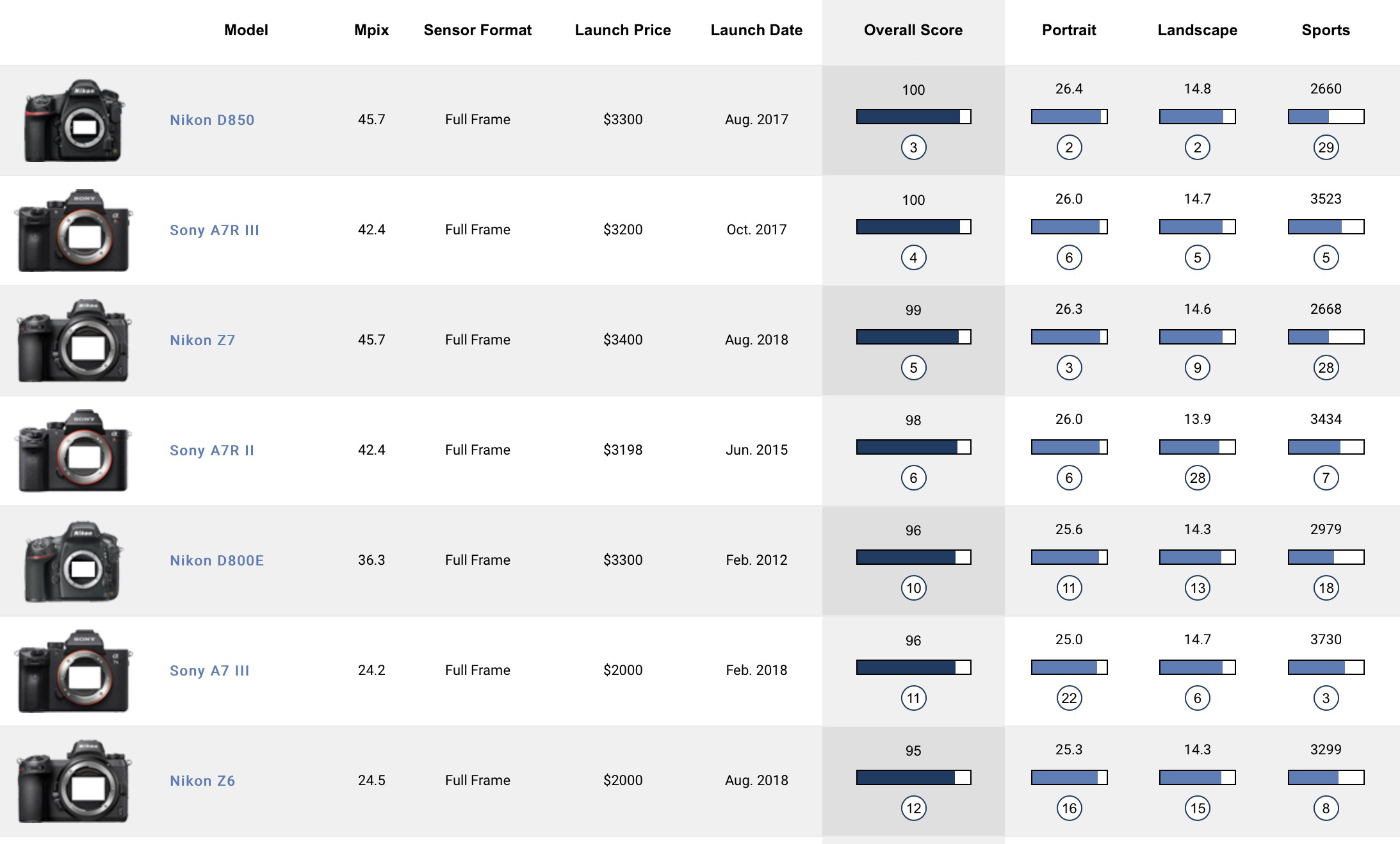
Click here to open our interactive DxOMark image sensor ranking tool.
In-depth comparisons
In this section, we’ll take a closer look at how the Nikon Z 7’s sensor scores in comparison with the Nikon D850 and with the Sony A7R III, its closest full-frame mirrorless rival.
Portrait (color depth)
For the majority of its sensitivity range, the Nikon Z 7’s color depth is very close to the Nikon D850 and the Sony A7R III. However, the D850 achieves a maximum value of 26.4 bits which is higher than the maximums scored by the Z 7 and the Sony A7R III. Technically, that means the D850 sensor can distinguish more colors, but with only 0.1 bit difference, it’s very unlikely to be noticeable in images.
At the highest ISO settings (25,600 and higher), the Z 7’s color depth drops below the D850’s and A7R III’s, which could be noticeable particularly in areas with smooth gradations.
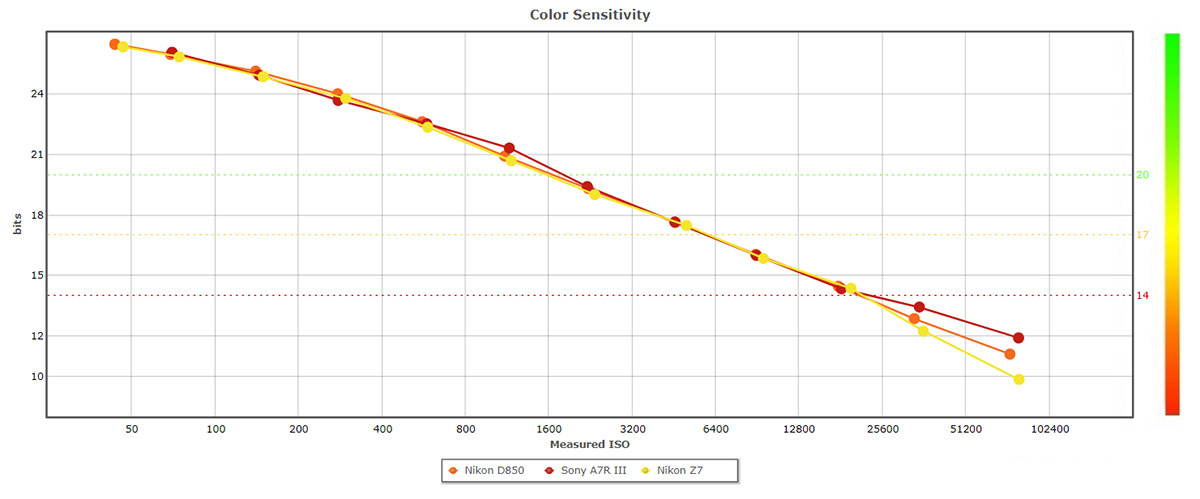
All three cameras in this comparison dip beneath our 20bit measure of good image quality when set to ISO 3200. At ISO 25,600, they all hover around the poor mark, but the Z 7 is above our 14-bit cut off.
Landscape (dynamic range)
With a measurement of over 14EV at ISO 100 and lower, the Nikon Z 7 has excellent dynamic range. Even at ISO 800, it achieves a score of over 12EV. That means that it’s capable of recording a wide range of tones in a single file. As a result, the images are fairly elastic and can be adjusted without introducing banding or noise becoming obvious too quickly.
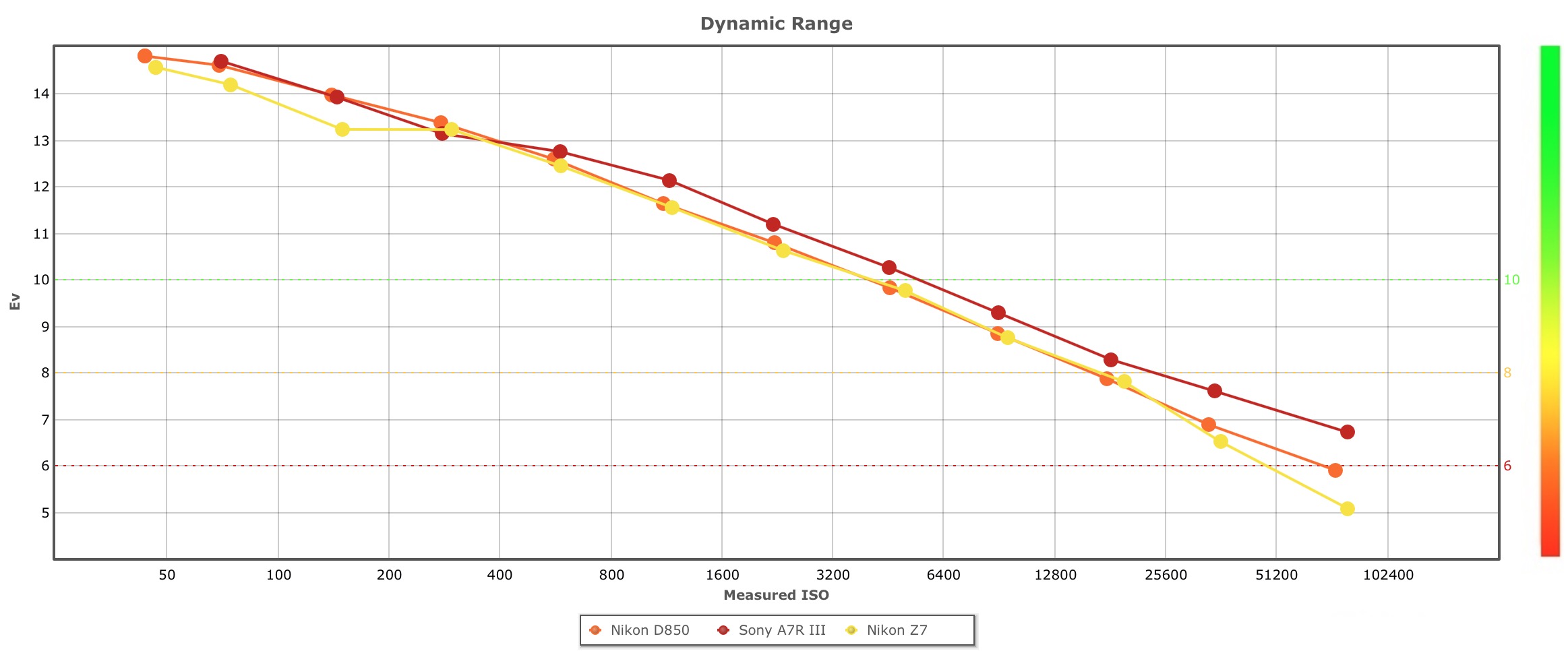
While the Nikon D850 achieves the highest dynamic range of the three sensors, the Sony A7R III has the highest value at settings of ISO 800 and above. Up to around ISO 25,600, the difference between the A7R III and the Z 7 is about 0.5EV, which while not dramatic, could be noticeable in some images—for example, some of the detail in bright clouds could be lost. Compared to the D850, the Z 7 drops slightly in dynamic range below ISO 200.
Sports (low-light ISO)
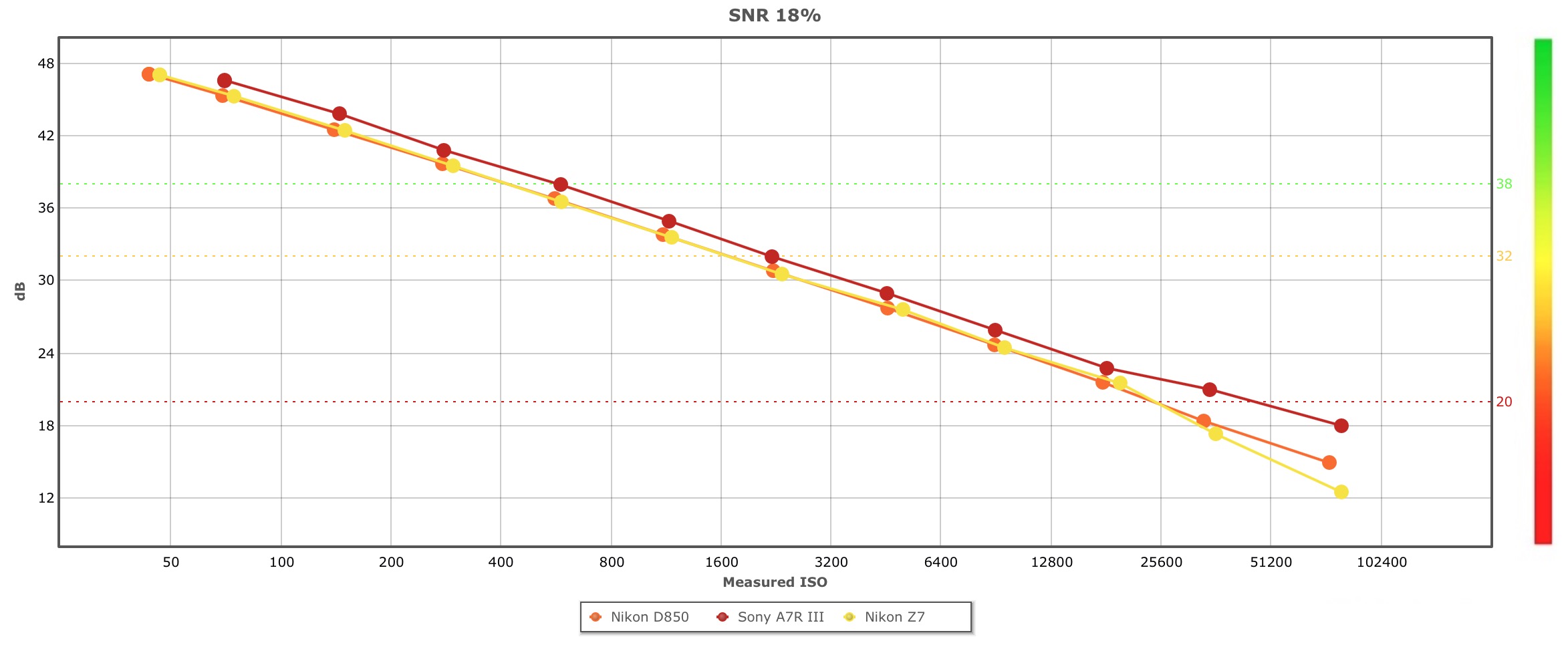
With the exception of the uppermost sensitivity values, the Nikon Z 7 has a near-identical signal-to-noise ratio to the D850. And although they are both very good, neither can match the Sony A7R III for the majority of the sensitivity range. That said, the values are so close that it’s very unlikely that you’d spot a difference among the images. However, combining the better noise control and dynamic range of the Sony A7R III at higher sensitivity settings could provide an advantage when brightening images post-capture.
Conclusion
It’s interesting that the Nikon Z 7’s sensor produces results that are similar but not identical to the D850’s. It’s possible that some of the differences can be attributed to the presence of phase-detection autofocus pixels on the imaging sensor.
The Z 7 performs well across the board, and the combination of a high pixel count (which enables it to record a lot of detail) and the sensor’s excellent color depth means that it is capable of producing images that are very pleasing to the eye. Factor in the excellent dynamic range, and the Z 7 looks like a good choice of camera for landscape photographers, wedding photographers, and keen amateurs alike.
In this review we have compared the Nikon Z 7 to its most direct rival and to relevant cameras we’ve tested among Nikon’s own lineup. As usual, you can create your own comparisons and in-depth analyses using our interactive image sensor ranking tool.


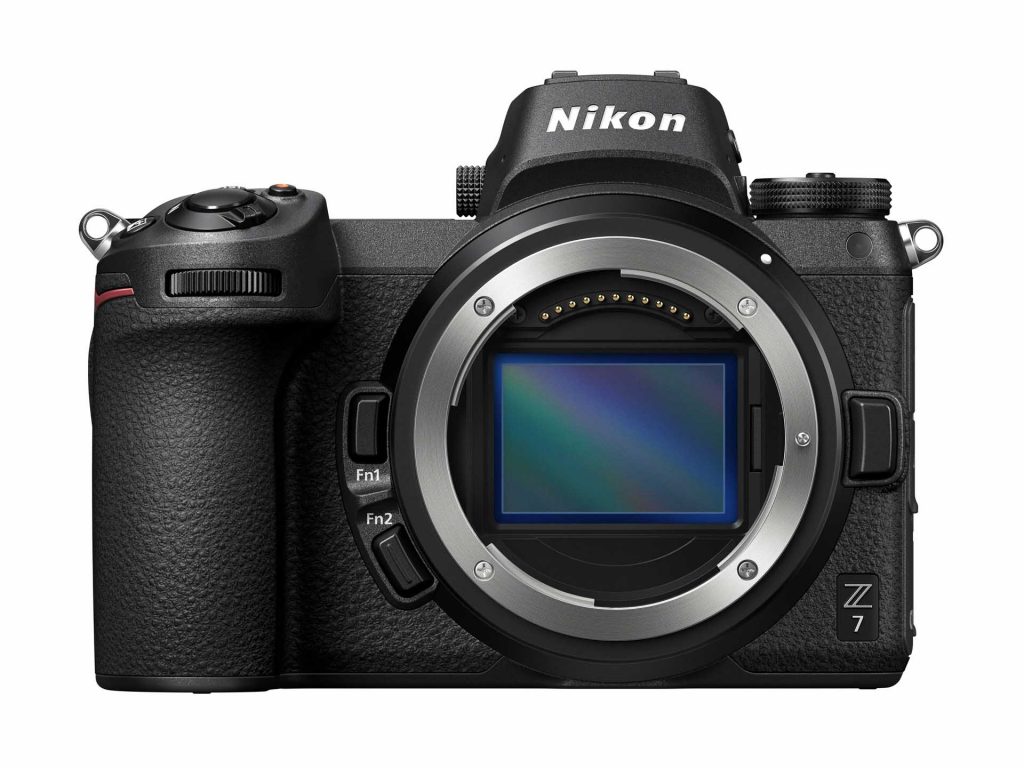


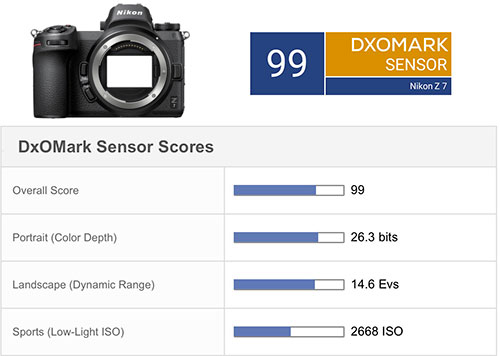


DXOMARK encourages its readers to share comments on the articles. To read or post comments, Disqus cookies are required. Change your Cookies Preferences and read more about our Comment Policy.